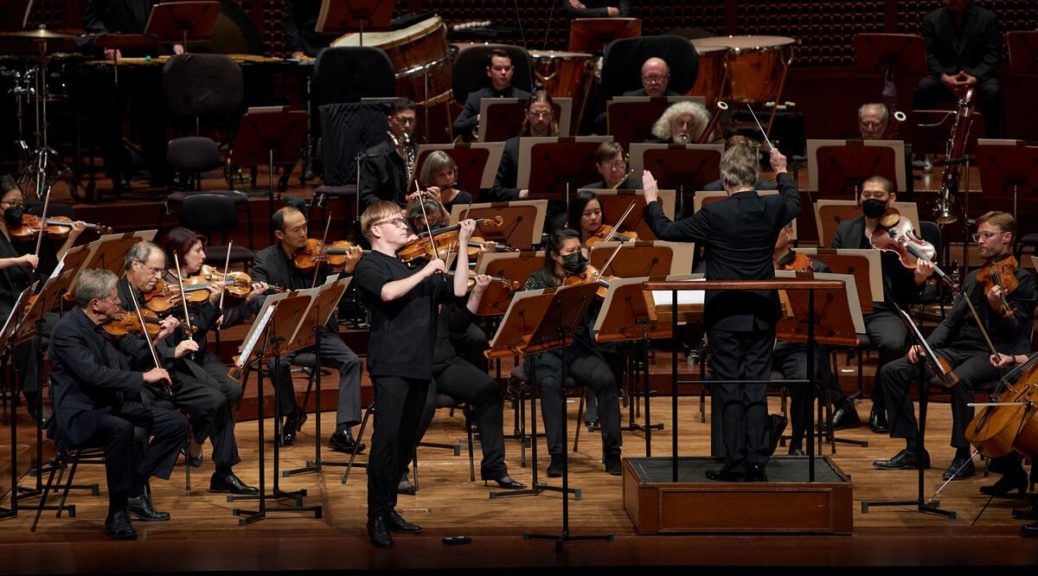
SYMPHONY’S NEW HIGH-RPM CONCERTO
If Paganini were a contemporary composer, he might be writing a rocket-powered violin concerto similar to Bryce Dessner’s, heard at the S.F. Symphony.
The great violin star Paganini once famously said to Berlioz, if I perform a new concerto, I have to be playing all the time.
Dessner’s new opus has the soloist playing frantically at breath-taking tempo, nearly nonstop, through 26 minutes in a whirlwind part of as many as 9,000 notes. The orchestra’s string players venture a similar pace but in more modest doses in what has to be one of the most challenging scores of the season.
The high-energy, high-speed solo is nearly as exhausting for the listener as the soloist, who in this case was the young Finnish virtuoso Pekka Kuusisto for whom it was written. His cadenza (solo-display discourse) was no less thorny, marked by left-hand pizzicatos as a surprise self-accompaniment. I don’t know if this fire-eater is the next Paganini. But I do know that, instead of retiring to a long well-deserved rest, he returned to render a charming Finnish folk tune called “Kopsin Jonas.”
His overwhelming concerto performance had been accorded a standing ovation by the live audience at Davies Hall. The role was so feverish that he hadn’t a spare second even to turn score pages. His score was an electronic monitor image, with “pages” turned by a pedal control.
The new Dessner concerto is like an express train setting a new trans- continental record running at an unbelievable RPM all the way, with just one (Omaha?) rest stop via its slow movement. The three-movement opus punctuates the virtuosic solo with sonic booms from the enlarged 6-member percussion section, with help from the hefty brass, both noteworthy in a chamber-orchestra-sized ensemble. The violin section enters with perpetual-motion figures and blinding tremolos. After the lyrical legatos of the slow movement, The finale reverts to presto fiddling, always with a pulse, sometimes with harsh blows on percussion.
The 44-year-old American expat Dessner cites two elements factored into the US-premiere concerto: Anne Carson’s essay “The Anthropology of Water,” and the pilgrimage to Santiago de Compostela in Northwest Spain. The water effects in music were elusive from our seat, unless perhaps you’re talking about Niagara Falls.
As for the pilgrimage, envision doing it, on foot of course, from Dessner’s home in the Bayonne France area to Santiago, some 450 miles, trudging 10- to 30-miles a day (I only did the last three miles, which merits neither plaudits nor diploma-like certificate). The rhythm of the long walk is much like the promenade theme of Mussorgsky’s “Pictures at an Exhibition,” at a tempo of about 84 beats per minute.
As the music tempos here often ran fast enough to turn Conductor Esa-Pekka Salonen’s baton into a blur, the pilgrimage image remained mostly in the mind.
The concert opened with Beethoven’s rarely heard “Leonore Overture No. 2,” which was at best a study for his great subsequent “Leonore Overture No. 3,” a work which capsulizes an entire opera with vigor. And it ended with Schubert’s familiar Symphony No. 5.
MUSIC NOTES—-Both Dessner and Kuusisto are among Salonen’s “collaborating partners,” an octet of highly creative performers and composers, engaged for occasional tasks and appearances…The new concerto was initially envisaged as even more tightly wound than here, as the given approximate length was estimated to take two minutes LESS, incredibly, than on Oct. 21.
SAN FRANCISCO SYMPHONY under Music Director Salonen at Davies Hall S.F. Oct. 21-23 playing Dessner, Beethoven, Schubert. For info: (415) 864-6000, or go online: www.sfsymphony.org.